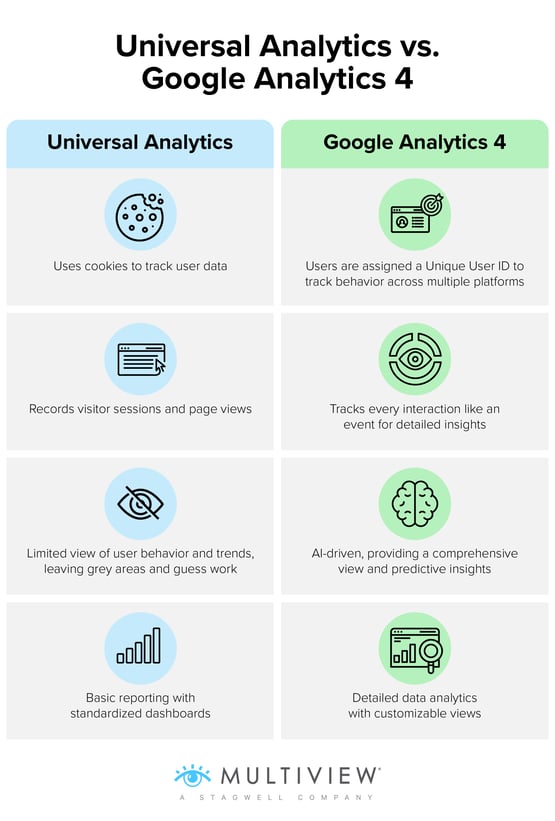The Biggest Changes GA4 is Bringing


Published on: August 23, 2023
Google Analytics 4 has officially launched as the new generation of web analytics. With even more capabilities and advanced features, marketers will not only need to learn the new navigation but how to capitalize on the AI-driven data and insights. If you feel a little behind, that's okay! We're all getting comfortable with the new interface, so here are the biggest changes you should be aware of while migrating.
Why the shift?One of the primary reasons Google decided to sunset Universal Analytics was to ensure consumer privacy. With heightened concerns around data usage and tracking, GA4 emphasizes safeguarding user information and online behavior to align with contemporary privacy regulations like GDPR and CCPA. The framework prioritizes privacy-first tracking, utilizing cross-channel data measurements rather than the use of cookies.
This transition to GA4 also involves integrating advanced technology to automate processes and enhance overall performance. It marks a significant leap forward in web analytics, enabling marketers to dive beyond basic traffic monitoring and into the possibilities of comprehensive customer behavior analysis. Rather than solely focusing on page visits, GA4 offers the capability to track users' complete journeys across various media channels. Powered by artificial intelligence (AI) and machine learning, it collects powerful, intricate insights into user interactions throughout both websites and apps.
Top updates
Tracking metrics
Metrics take on a new form with GA4. Instead of having only a snapshot of user interaction, now whenever a user interacts with your website, a Unique User ID is generated to track detailed metrics on behavior. This new methodology involves multiple data sources that gather insights on users, tapping into Google ID and other proprietary data instead of relying solely on cookies. Additionally, cross-platform tracking for both web and app experiences is now possible, enabling you to see the complete customer journey. GA4 reimagines measurement, making all metrics event-based, while introducing novel engagement metrics such as engagement rate, sessions, and time. For a more detailed breakdown, explore Google’s resource on GA4 Metrics.
Consolidation of data
Previously, managing analytics involved setting up multiple properties for each website and subdomain, which could become quite complex. However, GA4 streamlines this process by consolidating everything into a single universal view. This aggregation simplifies tracking since you only need one standard base code. With GA4, you gain the convenience of monitoring all aspects of your data in one glance through a customizable dashboard, creating a more efficient and holistic approach to data analysis. This also allows you to select and view all metrics of value, rather than what Google assumes to be a valuable metric.
AI integrations
Using AI integrations, GA4 brings a host of user-friendly tools that elevate tracking capabilities. It conducts a comprehensive site crawl to identify significant events or conversions, enabling automatic tracking initiation without any initial setup. From there, you can pick and choose further data points to track. This not only simplifies tracking but also facilitates effortless monetization of websites. Additionally, GA4 offers visibility into the most profitable areas, allowing you to pinpoint your best ROI sources. Seamlessly integrated into CRM systems, GA4 becomes a holistic data hub. With predictive learning, GA4 learns about users over time, harnessing this knowledge to anticipate future conversions and potential revenue opportunities based on user behavior patterns, further enhancing its predictive capabilities.
Disappearing data
A crucial step in this transition is ensuring the migration of your data from Universal Analytics. Since Universal Analytics ceased processing data on July 1, 2023, adopting GA4 means you'll no longer have your data housed there. To safeguard this historical data, you must extract it from Universal Analytics and store it within a data lake or another internal repository to prevent data loss. This data migration should be completed by the end of 2023 or it’ll be lost. For more guidance on how to complete your data migration, refer to Google’s Migration Walkthrough.

Conclusion
Embracing the transition to GA4 signifies a bold step toward a more sophisticated and data-rich era of analytics. While change can be daunting, rest assured that this shift equips you with enhanced capabilities and insights that will fuel your business growth. By adopting GA4, you're not just upgrading your analytics – you're laying the groundwork for smarter business decisions and more meaningful connections with your audience.
Explore the latest B2B topics and gain insight to adapt best practices for success and help grow your business.
There’s a certain romance to the idea of evergreen content. Publish once, watch it climb search rankings, and let it generate traffic indefinitely...
MoreAnyone producing content today has seen how quickly trust evaporates the moment an educational piece turns into a sales ambush. A guide starts...
MoreIn a world that often underestimates what people with disabilities can achieve, Vibrant Works is flipping the narrative — one job, one product, one...
MoreComplete the form below and we’ll get in touch with you right away.
You are now in accessibility mode. To restore settings to default, click the accessibility icon on the right hand side.